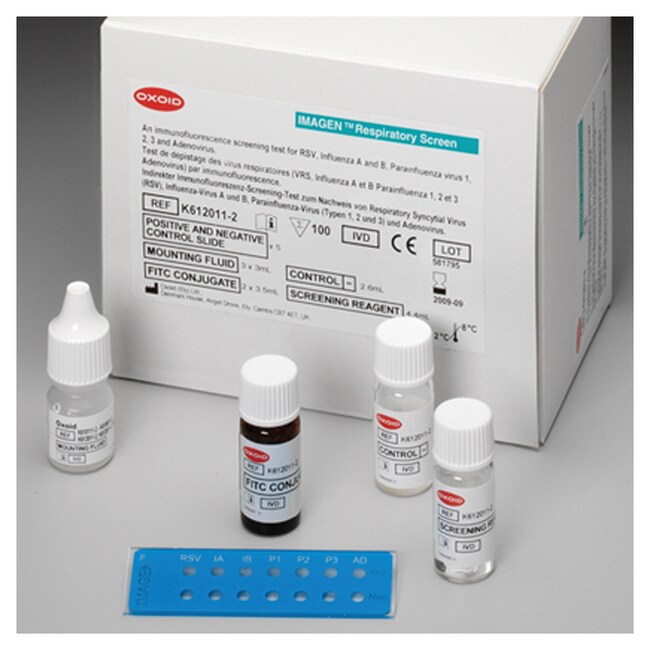Search Thermo Fisher Scientific
- Order Status
- Quick Order
-
Don't have an account ? Create Account
Search Thermo Fisher Scientific

Presumptively detect respiratory syncytical virus (RSV), influenza A and B virus, parainfluenza virus 1,2 & 3 and adenovirus in respiratory specimens with Thermo Scientific™ IMAGEN™ Respiratory Virus Screen Kit. The assay cannot differentiate between the viruses. Individual viruses should be further identified and confirmed using monospecific FITC labeled monoclonal antibody reagents, such as the IMAGEN range, or other methods. The direct respiratory specimen results must be confirmed by cell culture.
| Description | IMAGEN™ Respiratory Screen |
| Detectable Analytes | Respiratory Syncytial Virus (RSV) |
| Sample Type | Nasopharyngeal |
| Type | Reagent |
| Quantity | 100 Tests |
| Unit Size | Each |
| Catalog Number | Specifications | Unit Size | Quantity | Price (TWD) | |||||||||||||||||||||||||||||||||||||||||||||||||||||||||||||||||||||||||||||||||||||||||||||||||||||||||||
|---|---|---|---|---|---|---|---|---|---|---|---|---|---|---|---|---|---|---|---|---|---|---|---|---|---|---|---|---|---|---|---|---|---|---|---|---|---|---|---|---|---|---|---|---|---|---|---|---|---|---|---|---|---|---|---|---|---|---|---|---|---|---|---|---|---|---|---|---|---|---|---|---|---|---|---|---|---|---|---|---|---|---|---|---|---|---|---|---|---|---|---|---|---|---|---|---|---|---|---|---|---|---|---|---|---|---|---|---|---|---|---|
| K612011-2 | Each | 100 Tests | Request A Quote | ||||||||||||||||||||||||||||||||||||||||||||||||||||||||||||||||||||||||||||||||||||||||||||||||||||||||||||
| |||||||||||||||||||||||||||||||||||||||||||||||||||||||||||||||||||||||||||||||||||||||||||||||||||||||||||||||
Respiratory virus infections are associated with major outbreaks of respiratory disease throughout the world which have a significant impact on world health1,2,3. Viruses cause disease in all age groups but infections are most severe in infant, elderly and immunocompromised populations leading to hospitalization of patients4. Rapid diagnosis of respiratory virus infections is an important aid in the management of patients, prevention, and control of outbreaks, and in influencing the use of antiviral therapy, particularly for influenza A and RSV viral infections.3
Use IMAGEN Respiratory Virus Screen Kit as a rapid, sensitive, and specific method for the presumptive detection of respiratory syncytical virus (RSV), influenza A and B virus, parainfluenza virus 1,2 & 3 and adenovirus in respiratory specimens.
The viruses mainly responsible for lower respiratory tract infection include RSV, influenza A and B viruses, parainfluenza virus 1, 2 and 3 and adenoviruses. Expected prevalence rates for individual viruses are detailed (with references) in Section 13, Expected Values.
RSV and parainfluenza viruses occur seasonally and are major causes of lower respiratory tract disease in infants and young children. They frequently cause bronchiolitis, croup, bronchitis, and occasionally pneumonia5,6,7. Influenza A and B viruses cause worldwide seasonal epidemics of respiratory disease in adults and infants with a disease spectrum ranging from mild upper respiratory tract symptoms to severe pneumonia8,9. Acute pneumonia in elderly or immunocompromised patients can be life-threatening, particularly when associated with secondary microbial infections.
Adenovirus infections are associated with respiratory, ocular, and enteric disease10. Adenoviruses are reported to be responsible for 5% of acute respiratory diseases in children under the age of 4 years and are a common cause of pharyngitis in young children11.
Not all products are available for sale in all territories. Please inquire.
Remel™ and Oxoid™ products are now part of the Thermo Scientific brand.